Practical Data Analysis: Ethnicity Pay Gap in Great Britain
VerifiedAdded on 2022/12/22
|16
|3777
|77
Report
AI Summary
This report provides a practical data analysis of the ethnicity pay gap in Great Britain, examining the differences in hourly pay between White British and ethnic minority employees. The study reveals that while the pay gap has narrowed since 2017, significant disparities persist, with higher employment rates among White British individuals contributing to the ongoing gap. The analysis explores factors such as gender, age, and experience, highlighting that companies often favor older, more experienced employees, predominantly White British. The report includes a literature review, findings and analysis of the current situation, and descriptive statistics to support the claims. The report concludes with recommendations to minimize the ethnicity pay gap and ensure fair compensation for all employees. Data from various sources, including the Annual Population Survey, is used to support the findings. The report also explores the relationship between the ethnicity pay gap and gender, with a strong correlation found between men and women.

Practical data analysis
for business
for business
Paraphrase This Document
Need a fresh take? Get an instant paraphrase of this document with our AI Paraphraser

Abstract
The present study assists to identify the ethnicity pay gap within Great Britain and the findings
elaborates that the gap is narrowed since 2017. However, there is a high employment rates within
White British as compared to other ethnic groups and that is why, the gap did not minimize.
Apart from this, there is a gap between male and female within ethnic groups and also companies
prefer old age people as compared to young one because of having good experience in
professional industry. Therefore, study also present list of ways through which ethnicity can be
minimized within UK and also provide good pay to all employees without any discrimination on
the basis of race.
The present study assists to identify the ethnicity pay gap within Great Britain and the findings
elaborates that the gap is narrowed since 2017. However, there is a high employment rates within
White British as compared to other ethnic groups and that is why, the gap did not minimize.
Apart from this, there is a gap between male and female within ethnic groups and also companies
prefer old age people as compared to young one because of having good experience in
professional industry. Therefore, study also present list of ways through which ethnicity can be
minimized within UK and also provide good pay to all employees without any discrimination on
the basis of race.
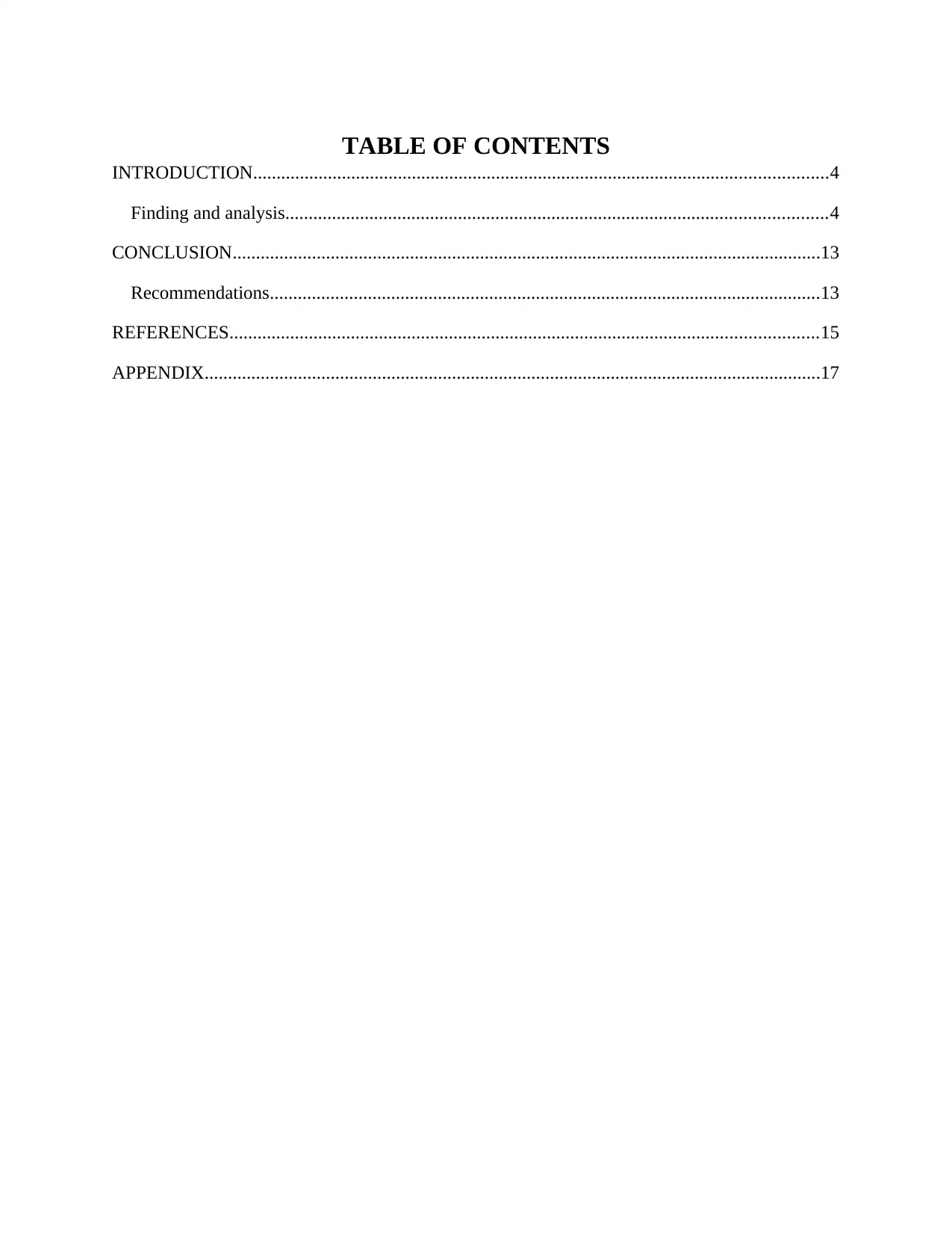
TABLE OF CONTENTS
INTRODUCTION...........................................................................................................................4
Finding and analysis....................................................................................................................4
CONCLUSION..............................................................................................................................13
Recommendations......................................................................................................................13
REFERENCES..............................................................................................................................15
APPENDIX....................................................................................................................................17
INTRODUCTION...........................................................................................................................4
Finding and analysis....................................................................................................................4
CONCLUSION..............................................................................................................................13
Recommendations......................................................................................................................13
REFERENCES..............................................................................................................................15
APPENDIX....................................................................................................................................17
⊘ This is a preview!⊘
Do you want full access?
Subscribe today to unlock all pages.

Trusted by 1+ million students worldwide

INTRODUCTION
Race is considered one of the most protected characteristic in Equality Act, 2010 and as
per the act, it is an unlawful discrimination which is performed within any state due to certain
reasons (Longhi and Brynin, 2017). Therefore, race refers to color or nationality and it is mainly
found between white and black peoples. For that, Black, Asian and Minority ethnic people
(BAME) was formed with an idea to fight against discrimination in 1970s. The present study is
also based upon ethnicity pay gap in Great Britain. The term refers to the difference in average
hourly rate of pay between BAME and non BAME employees within an organization. For that,
study will explain the issue faced by the people and provide recommendations to improve the
same.
Literature review
According to Costa Dias, Joyce and Parodi, (2020) the highest percentage of people who
working in Great Britain is White British which is 79.5% of the working population and further
it is followed by white other (7.9%) and then Black African or Black British (3.2%). Therefore, it
is reflected that the ethnic group working within Great Britain is of smallest proportion and even
they work high as compared to others. It is also supported by Aspinall (2020) that organizations
do not prefer minority groups due to their arrival from other country and that is why, they face
some difficulties to understand the culture of UK as compared to those people who born in UK.
Thus, proportion of Black, Asian and other ethnic minorities will rise from 8% to 20% by 2051
(UK’s ethnic minority numbers to rise to 20% by 2051, 2015). Also, among all black and Asian
population are increase significantly due to expected high level of immigration from Europe and
Australia.
de Noronha (2019) also investigated that White British was the largest group among all
ethnic group and also the pay gap is higher among White British as compared to other because of
their culture and education background. That is why, it also leads to a difference between the
men and women pay gap as well. Such that by taking into account factors such as age, sex,
marital status, qualification, country of birth further narrow the gap for many ethnic groups.
Also, as per the data provided above (pay on the basis of age), it is also examined that White
British whose age is above 30 are earn more as compared to other ethnic groups. This is because,
company prefer White people who have good experience (it comes when they involved
Race is considered one of the most protected characteristic in Equality Act, 2010 and as
per the act, it is an unlawful discrimination which is performed within any state due to certain
reasons (Longhi and Brynin, 2017). Therefore, race refers to color or nationality and it is mainly
found between white and black peoples. For that, Black, Asian and Minority ethnic people
(BAME) was formed with an idea to fight against discrimination in 1970s. The present study is
also based upon ethnicity pay gap in Great Britain. The term refers to the difference in average
hourly rate of pay between BAME and non BAME employees within an organization. For that,
study will explain the issue faced by the people and provide recommendations to improve the
same.
Literature review
According to Costa Dias, Joyce and Parodi, (2020) the highest percentage of people who
working in Great Britain is White British which is 79.5% of the working population and further
it is followed by white other (7.9%) and then Black African or Black British (3.2%). Therefore, it
is reflected that the ethnic group working within Great Britain is of smallest proportion and even
they work high as compared to others. It is also supported by Aspinall (2020) that organizations
do not prefer minority groups due to their arrival from other country and that is why, they face
some difficulties to understand the culture of UK as compared to those people who born in UK.
Thus, proportion of Black, Asian and other ethnic minorities will rise from 8% to 20% by 2051
(UK’s ethnic minority numbers to rise to 20% by 2051, 2015). Also, among all black and Asian
population are increase significantly due to expected high level of immigration from Europe and
Australia.
de Noronha (2019) also investigated that White British was the largest group among all
ethnic group and also the pay gap is higher among White British as compared to other because of
their culture and education background. That is why, it also leads to a difference between the
men and women pay gap as well. Such that by taking into account factors such as age, sex,
marital status, qualification, country of birth further narrow the gap for many ethnic groups.
Also, as per the data provided above (pay on the basis of age), it is also examined that White
British whose age is above 30 are earn more as compared to other ethnic groups. This is because,
company prefer White people who have good experience (it comes when they involved
Paraphrase This Document
Need a fresh take? Get an instant paraphrase of this document with our AI Paraphraser

themselves within professional industry). Therefore, Iganski and Mason (2018) shared their
views that ethnic minorities are around twice as likely to be employed as comparted with White
British. It is so because 47% group work on zero hour contracts and hence, they less likely to
benefit from legal protection in a workplace (Understanding pay gaps, 2020).
As compared to past years it is examined by Paccoud, Niesseron and Mace (2020) that
when an organization compares worker with same qualification or experience like general
worker of Bangladesh and White British man, they prefer person of color who is still likely to
earn significantly less. In addition to this, it is also analyzed that companies also prefer those
people who born within UK and knows the entire culture whereas other minorities people such
as Asian, Black British, Indian and Pakistani are less preferred due to their race and low
experience tow work in such group. Hence, as per the Annual Population Survey (APS) report it
is clearly mentioned that earning of white people is more as compared to ethnic groups and that
is why, majority of such group is higher as compared to others.
Overall it can be stated that white other ethnic group is one of the most prominent ethnic
group over white British. Razai and et.al., (2021) reflected that UK is a part of European
Economic Area where people have a right to move freely of any country and that is why they
share the highest numbers. Further, as per Annual Population Survey, 2018 report it has been
analyzed that White other have a highest employment rate as compared to other ethnic group but
this is changed in 2019. That is why, government has to take steps in order to minimize the
ethnicity.
Finding and analysis
The pay gap between white British workers and other ethnic worker’s groups is largely in
favor of whites and this reflect that there is a race discrimination occur in the nation. Also, pay
discrimination probably occurs in temporary, casual and generally insecure work in which
minorities are over represented. Though it is difficult for the organizations to pay less top the
people, but most of the organizations perform the same on the basis of ethnicity. By analyzing
the situation since 2017, it has been compulsory for companies in Great Britain who have 250
employees to present the data of gender pay gaps in each financial year (Platt and Warwick,
2020). Thus, UK government also begun to publish their ethnicity pay gap on annual basis. Thus,
views that ethnic minorities are around twice as likely to be employed as comparted with White
British. It is so because 47% group work on zero hour contracts and hence, they less likely to
benefit from legal protection in a workplace (Understanding pay gaps, 2020).
As compared to past years it is examined by Paccoud, Niesseron and Mace (2020) that
when an organization compares worker with same qualification or experience like general
worker of Bangladesh and White British man, they prefer person of color who is still likely to
earn significantly less. In addition to this, it is also analyzed that companies also prefer those
people who born within UK and knows the entire culture whereas other minorities people such
as Asian, Black British, Indian and Pakistani are less preferred due to their race and low
experience tow work in such group. Hence, as per the Annual Population Survey (APS) report it
is clearly mentioned that earning of white people is more as compared to ethnic groups and that
is why, majority of such group is higher as compared to others.
Overall it can be stated that white other ethnic group is one of the most prominent ethnic
group over white British. Razai and et.al., (2021) reflected that UK is a part of European
Economic Area where people have a right to move freely of any country and that is why they
share the highest numbers. Further, as per Annual Population Survey, 2018 report it has been
analyzed that White other have a highest employment rate as compared to other ethnic group but
this is changed in 2019. That is why, government has to take steps in order to minimize the
ethnicity.
Finding and analysis
The pay gap between white British workers and other ethnic worker’s groups is largely in
favor of whites and this reflect that there is a race discrimination occur in the nation. Also, pay
discrimination probably occurs in temporary, casual and generally insecure work in which
minorities are over represented. Though it is difficult for the organizations to pay less top the
people, but most of the organizations perform the same on the basis of ethnicity. By analyzing
the situation since 2017, it has been compulsory for companies in Great Britain who have 250
employees to present the data of gender pay gaps in each financial year (Platt and Warwick,
2020). Thus, UK government also begun to publish their ethnicity pay gap on annual basis. Thus,
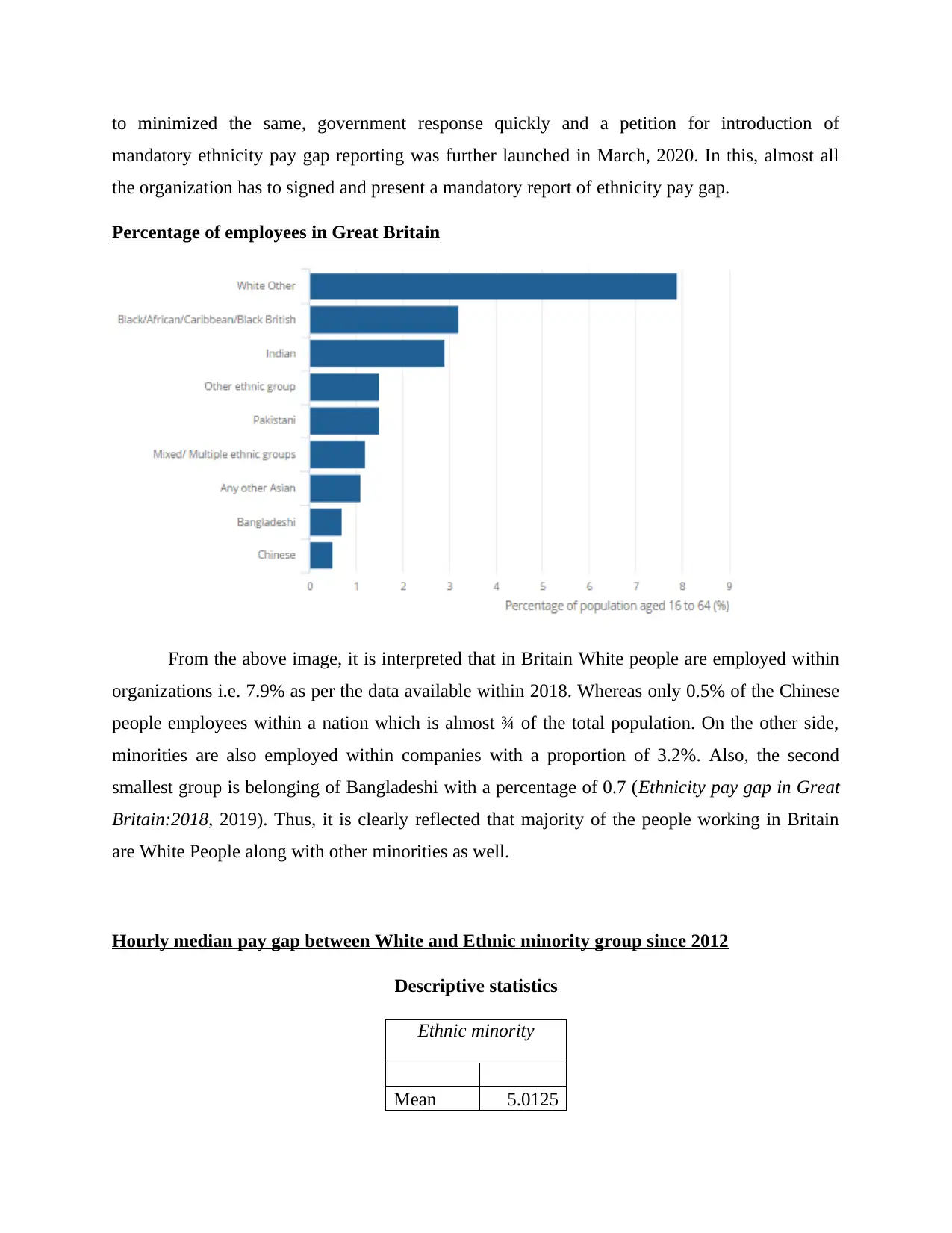
to minimized the same, government response quickly and a petition for introduction of
mandatory ethnicity pay gap reporting was further launched in March, 2020. In this, almost all
the organization has to signed and present a mandatory report of ethnicity pay gap.
Percentage of employees in Great Britain
From the above image, it is interpreted that in Britain White people are employed within
organizations i.e. 7.9% as per the data available within 2018. Whereas only 0.5% of the Chinese
people employees within a nation which is almost ¾ of the total population. On the other side,
minorities are also employed within companies with a proportion of 3.2%. Also, the second
smallest group is belonging of Bangladeshi with a percentage of 0.7 (Ethnicity pay gap in Great
Britain:2018, 2019). Thus, it is clearly reflected that majority of the people working in Britain
are White People along with other minorities as well.
Hourly median pay gap between White and Ethnic minority group since 2012
Descriptive statistics
Ethnic minority
Mean 5.0125
mandatory ethnicity pay gap reporting was further launched in March, 2020. In this, almost all
the organization has to signed and present a mandatory report of ethnicity pay gap.
Percentage of employees in Great Britain
From the above image, it is interpreted that in Britain White people are employed within
organizations i.e. 7.9% as per the data available within 2018. Whereas only 0.5% of the Chinese
people employees within a nation which is almost ¾ of the total population. On the other side,
minorities are also employed within companies with a proportion of 3.2%. Also, the second
smallest group is belonging of Bangladeshi with a percentage of 0.7 (Ethnicity pay gap in Great
Britain:2018, 2019). Thus, it is clearly reflected that majority of the people working in Britain
are White People along with other minorities as well.
Hourly median pay gap between White and Ethnic minority group since 2012
Descriptive statistics
Ethnic minority
Mean 5.0125
⊘ This is a preview!⊘
Do you want full access?
Subscribe today to unlock all pages.

Trusted by 1+ million students worldwide
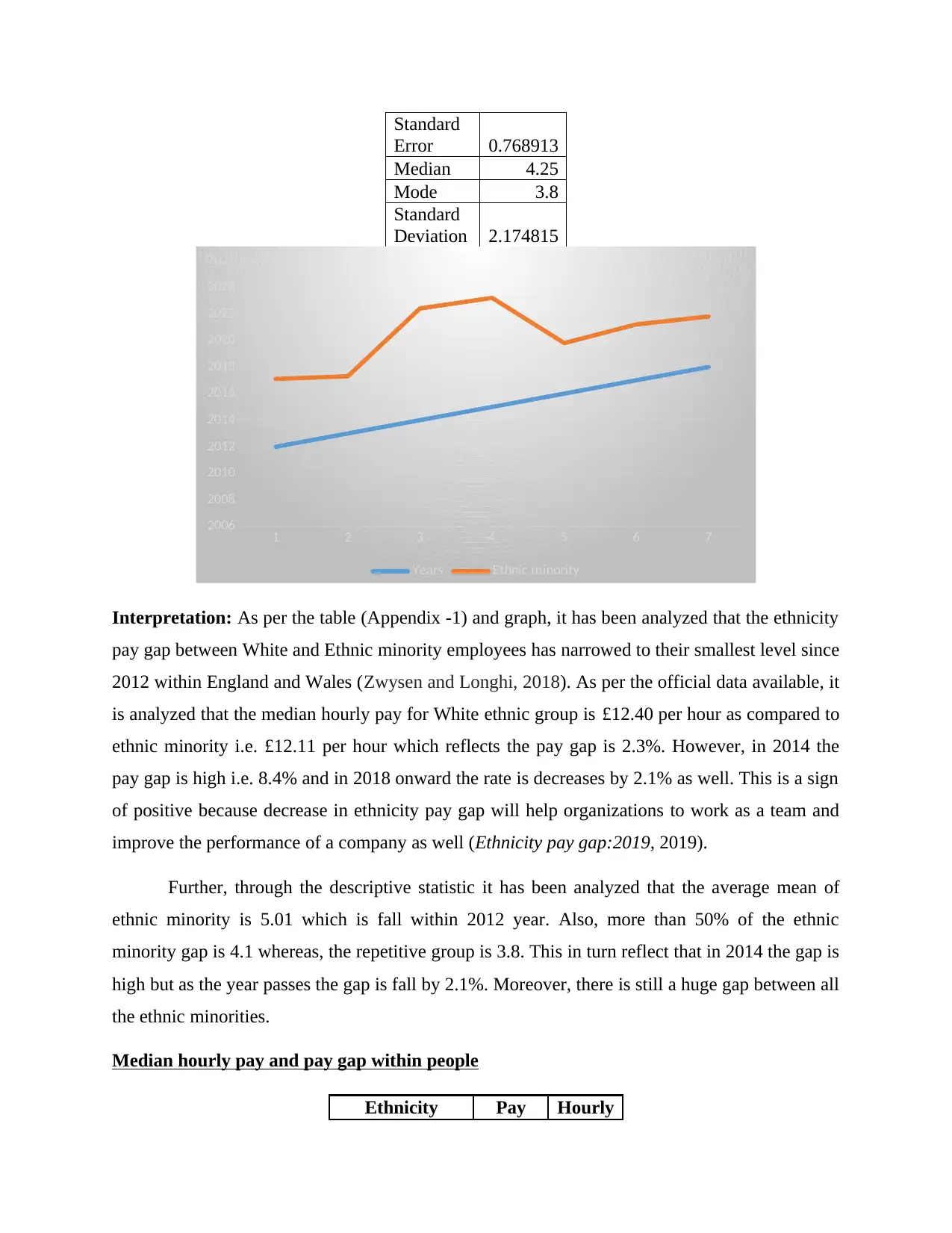
Standard
Error 0.768913
Median 4.25
Mode 3.8
Standard
Deviation 2.174815
1 2 3 4 5 6 7
2006
2008
2010
2012
2014
2016
2018
2020
2022
2024
2026
Years Ethnic minority
Interpretation: As per the table (Appendix -1) and graph, it has been analyzed that the ethnicity
pay gap between White and Ethnic minority employees has narrowed to their smallest level since
2012 within England and Wales (Zwysen and Longhi, 2018). As per the official data available, it
is analyzed that the median hourly pay for White ethnic group is £12.40 per hour as compared to
ethnic minority i.e. £12.11 per hour which reflects the pay gap is 2.3%. However, in 2014 the
pay gap is high i.e. 8.4% and in 2018 onward the rate is decreases by 2.1% as well. This is a sign
of positive because decrease in ethnicity pay gap will help organizations to work as a team and
improve the performance of a company as well (Ethnicity pay gap:2019, 2019).
Further, through the descriptive statistic it has been analyzed that the average mean of
ethnic minority is 5.01 which is fall within 2012 year. Also, more than 50% of the ethnic
minority gap is 4.1 whereas, the repetitive group is 3.8. This in turn reflect that in 2014 the gap is
high but as the year passes the gap is fall by 2.1%. Moreover, there is still a huge gap between all
the ethnic minorities.
Median hourly pay and pay gap within people
Ethnicity Pay Hourly
Error 0.768913
Median 4.25
Mode 3.8
Standard
Deviation 2.174815
1 2 3 4 5 6 7
2006
2008
2010
2012
2014
2016
2018
2020
2022
2024
2026
Years Ethnic minority
Interpretation: As per the table (Appendix -1) and graph, it has been analyzed that the ethnicity
pay gap between White and Ethnic minority employees has narrowed to their smallest level since
2012 within England and Wales (Zwysen and Longhi, 2018). As per the official data available, it
is analyzed that the median hourly pay for White ethnic group is £12.40 per hour as compared to
ethnic minority i.e. £12.11 per hour which reflects the pay gap is 2.3%. However, in 2014 the
pay gap is high i.e. 8.4% and in 2018 onward the rate is decreases by 2.1% as well. This is a sign
of positive because decrease in ethnicity pay gap will help organizations to work as a team and
improve the performance of a company as well (Ethnicity pay gap:2019, 2019).
Further, through the descriptive statistic it has been analyzed that the average mean of
ethnic minority is 5.01 which is fall within 2012 year. Also, more than 50% of the ethnic
minority gap is 4.1 whereas, the repetitive group is 3.8. This in turn reflect that in 2014 the gap is
high but as the year passes the gap is fall by 2.1%. Moreover, there is still a huge gap between all
the ethnic minorities.
Median hourly pay and pay gap within people
Ethnicity Pay Hourly
Paraphrase This Document
Need a fresh take? Get an instant paraphrase of this document with our AI Paraphraser

Gap
(%) pay (£)
Black Caribbean 3.7 12.03
Black African 7.9 11.5
Other Asian
background 7.5 11.55
Other Black /
African /
Caribbean
background
4.7 11.9
Other ethnic
group 8.5 11.43
Other White
(incl
gypsy/traveller)
7.6 11.54
White and Asian -7 13.37
White and Black
African 15.4 10.57
White and Black
Caribbean 12.6 10.92
White British 0 12.49
Black Caribbean
BlackAfrican
Other Asian background
Other Black / African / Caribbean background
Other ethnic group
Other White (incl gypsy/traveller)
White and Asian
White and Black African
White and Black Caribbean
White British
-10
-5
0
5
10
15
20
3.7
7.9 7.5
4.7
8.5 7.6
-7
15.4
12.6
0
12.03 11.5 11.55 11.9 11.43 11.54 13.37
10.57 10.92 12.49
Earning of people within Great Britain
Pay Gap (%) Hourly pay (£)
(%) pay (£)
Black Caribbean 3.7 12.03
Black African 7.9 11.5
Other Asian
background 7.5 11.55
Other Black /
African /
Caribbean
background
4.7 11.9
Other ethnic
group 8.5 11.43
Other White
(incl
gypsy/traveller)
7.6 11.54
White and Asian -7 13.37
White and Black
African 15.4 10.57
White and Black
Caribbean 12.6 10.92
White British 0 12.49
Black Caribbean
BlackAfrican
Other Asian background
Other Black / African / Caribbean background
Other ethnic group
Other White (incl gypsy/traveller)
White and Asian
White and Black African
White and Black Caribbean
White British
-10
-5
0
5
10
15
20
3.7
7.9 7.5
4.7
8.5 7.6
-7
15.4
12.6
0
12.03 11.5 11.55 11.9 11.43 11.54 13.37
10.57 10.92 12.49
Earning of people within Great Britain
Pay Gap (%) Hourly pay (£)
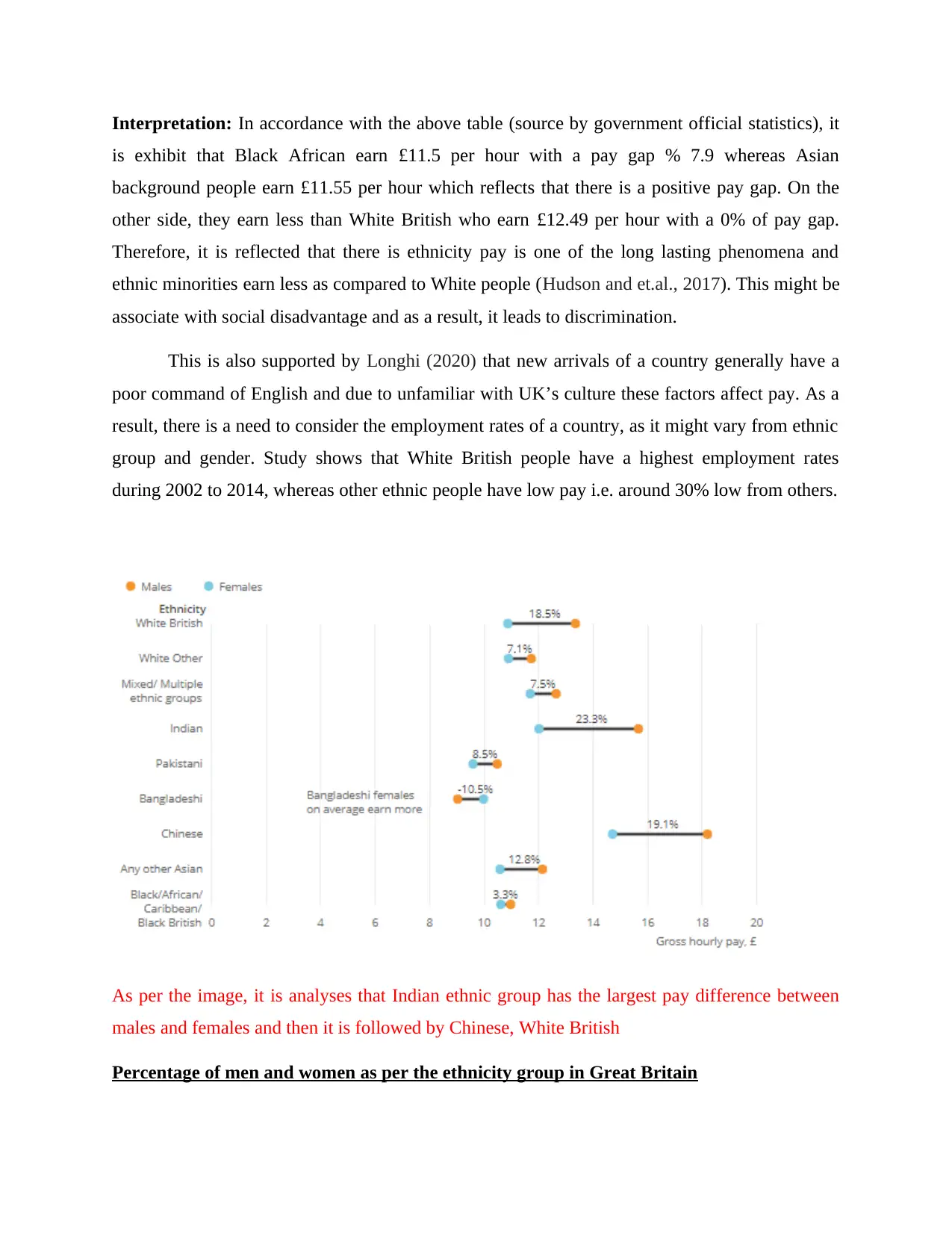
Interpretation: In accordance with the above table (source by government official statistics), it
is exhibit that Black African earn £11.5 per hour with a pay gap % 7.9 whereas Asian
background people earn £11.55 per hour which reflects that there is a positive pay gap. On the
other side, they earn less than White British who earn £12.49 per hour with a 0% of pay gap.
Therefore, it is reflected that there is ethnicity pay is one of the long lasting phenomena and
ethnic minorities earn less as compared to White people (Hudson and et.al., 2017). This might be
associate with social disadvantage and as a result, it leads to discrimination.
This is also supported by Longhi (2020) that new arrivals of a country generally have a
poor command of English and due to unfamiliar with UK’s culture these factors affect pay. As a
result, there is a need to consider the employment rates of a country, as it might vary from ethnic
group and gender. Study shows that White British people have a highest employment rates
during 2002 to 2014, whereas other ethnic people have low pay i.e. around 30% low from others.
As per the image, it is analyses that Indian ethnic group has the largest pay difference between
males and females and then it is followed by Chinese, White British
Percentage of men and women as per the ethnicity group in Great Britain
is exhibit that Black African earn £11.5 per hour with a pay gap % 7.9 whereas Asian
background people earn £11.55 per hour which reflects that there is a positive pay gap. On the
other side, they earn less than White British who earn £12.49 per hour with a 0% of pay gap.
Therefore, it is reflected that there is ethnicity pay is one of the long lasting phenomena and
ethnic minorities earn less as compared to White people (Hudson and et.al., 2017). This might be
associate with social disadvantage and as a result, it leads to discrimination.
This is also supported by Longhi (2020) that new arrivals of a country generally have a
poor command of English and due to unfamiliar with UK’s culture these factors affect pay. As a
result, there is a need to consider the employment rates of a country, as it might vary from ethnic
group and gender. Study shows that White British people have a highest employment rates
during 2002 to 2014, whereas other ethnic people have low pay i.e. around 30% low from others.
As per the image, it is analyses that Indian ethnic group has the largest pay difference between
males and females and then it is followed by Chinese, White British
Percentage of men and women as per the ethnicity group in Great Britain
⊘ This is a preview!⊘
Do you want full access?
Subscribe today to unlock all pages.

Trusted by 1+ million students worldwide

Female Male
Arab 12.49 12.1
Bangladeshi 10.6 10.41
Black Caribbean 12.09 12.03
Other Black /
African /
Caribbean
background 11.53 12.28
White Irish 16.93 17.8
Other ethnic
group 11.11 12.03
Other Asian
background 11.06 12.16
Other White
(including Gypsy
Traveller) 10.95 12.07
Other Mixed /
multiple ethnic
background 12.07 13.28
Black African 10.92 12.13
Pakistani 10.1 11.43
White and Asian 12.5 14.43
White British 11.21 13.78
White and Black
African 10.13 12.82
White and Black
Caribbean 9.71 12.76
Chinese 14.16 18.05
Indian 12.39 16.49
Correlation 0.79
Interpretation: In accordance with the above table, it is interpreted that there is a strong
relationship between men and women i.e. 79%. On the other side, it is also examined that in
White British male earn high as compared to women. Whereas, in Black Caribbean, the pay of
female as compared to male are slightly high (Atkinson and et.al., 2018). Apart from this, there
is a wide difference between the pay gap of White and Black African men, women and this
might be relying either age factor or type of work.
Arab 12.49 12.1
Bangladeshi 10.6 10.41
Black Caribbean 12.09 12.03
Other Black /
African /
Caribbean
background 11.53 12.28
White Irish 16.93 17.8
Other ethnic
group 11.11 12.03
Other Asian
background 11.06 12.16
Other White
(including Gypsy
Traveller) 10.95 12.07
Other Mixed /
multiple ethnic
background 12.07 13.28
Black African 10.92 12.13
Pakistani 10.1 11.43
White and Asian 12.5 14.43
White British 11.21 13.78
White and Black
African 10.13 12.82
White and Black
Caribbean 9.71 12.76
Chinese 14.16 18.05
Indian 12.39 16.49
Correlation 0.79
Interpretation: In accordance with the above table, it is interpreted that there is a strong
relationship between men and women i.e. 79%. On the other side, it is also examined that in
White British male earn high as compared to women. Whereas, in Black Caribbean, the pay of
female as compared to male are slightly high (Atkinson and et.al., 2018). Apart from this, there
is a wide difference between the pay gap of White and Black African men, women and this
might be relying either age factor or type of work.
Paraphrase This Document
Need a fresh take? Get an instant paraphrase of this document with our AI Paraphraser

Pay on the basis of Age
Age 16-29 Age 30+
% £ % £
Black Caribbean -2.7 10.09 7.6 12.66
Black African -12.8 11.08 15.7 11.55
Other Asian background 0.7 9.75 12.2 12.03
Other Black / African /
Caribbean background -6.4 10.45 7.7 12.65
Other ethnic group -2.9 10.1 15.4 11.59
White and Asian -20 11.78 -14.1 15.63
White and Black African 1.4 9.68 -0.9 13.82
White and Black Caribbean 4.5 9.38 6.3 12.84
White British 0 9.82 0 13.7
Black Caribbean
BlackAfrican
Other Asian background
Other Black / African / Caribbean background
Other ethnic group
White and Asian
White and Black African
White and Black Caribbean
White British
0
10
20
30
P a y o n the b asis o f a g e
16-29 Series2 30+
Age 16-29 Age 30+
% £ % £
Black Caribbean -2.7 10.09 7.6 12.66
Black African -12.8 11.08 15.7 11.55
Other Asian background 0.7 9.75 12.2 12.03
Other Black / African /
Caribbean background -6.4 10.45 7.7 12.65
Other ethnic group -2.9 10.1 15.4 11.59
White and Asian -20 11.78 -14.1 15.63
White and Black African 1.4 9.68 -0.9 13.82
White and Black Caribbean 4.5 9.38 6.3 12.84
White British 0 9.82 0 13.7
Black Caribbean
BlackAfrican
Other Asian background
Other Black / African / Caribbean background
Other ethnic group
White and Asian
White and Black African
White and Black Caribbean
White British
0
10
20
30
P a y o n the b asis o f a g e
16-29 Series2 30+
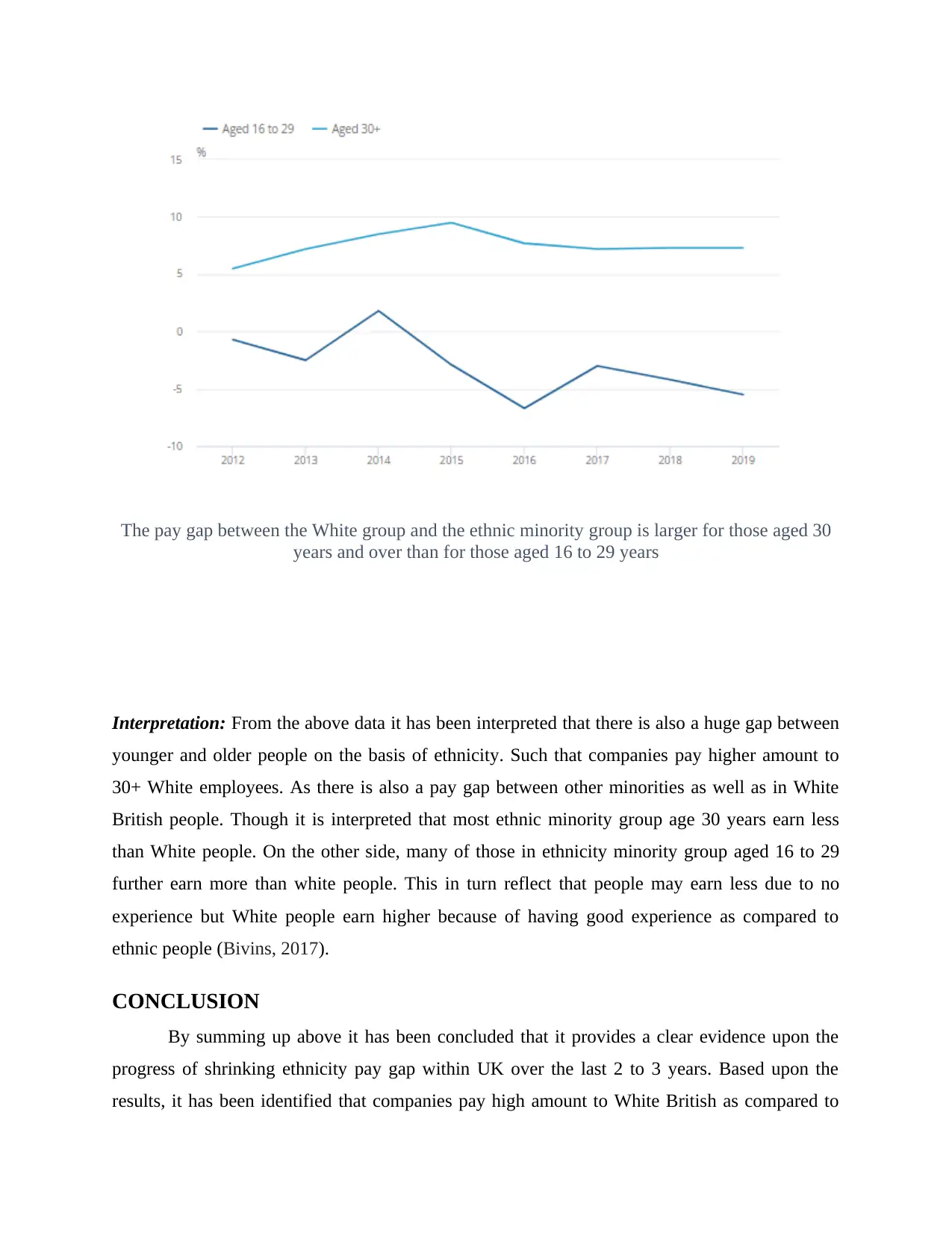
The pay gap between the White group and the ethnic minority group is larger for those aged 30
years and over than for those aged 16 to 29 years
Interpretation: From the above data it has been interpreted that there is also a huge gap between
younger and older people on the basis of ethnicity. Such that companies pay higher amount to
30+ White employees. As there is also a pay gap between other minorities as well as in White
British people. Though it is interpreted that most ethnic minority group age 30 years earn less
than White people. On the other side, many of those in ethnicity minority group aged 16 to 29
further earn more than white people. This in turn reflect that people may earn less due to no
experience but White people earn higher because of having good experience as compared to
ethnic people (Bivins, 2017).
CONCLUSION
By summing up above it has been concluded that it provides a clear evidence upon the
progress of shrinking ethnicity pay gap within UK over the last 2 to 3 years. Based upon the
results, it has been identified that companies pay high amount to White British as compared to
years and over than for those aged 16 to 29 years
Interpretation: From the above data it has been interpreted that there is also a huge gap between
younger and older people on the basis of ethnicity. Such that companies pay higher amount to
30+ White employees. As there is also a pay gap between other minorities as well as in White
British people. Though it is interpreted that most ethnic minority group age 30 years earn less
than White people. On the other side, many of those in ethnicity minority group aged 16 to 29
further earn more than white people. This in turn reflect that people may earn less due to no
experience but White people earn higher because of having good experience as compared to
ethnic people (Bivins, 2017).
CONCLUSION
By summing up above it has been concluded that it provides a clear evidence upon the
progress of shrinking ethnicity pay gap within UK over the last 2 to 3 years. Based upon the
results, it has been identified that companies pay high amount to White British as compared to
⊘ This is a preview!⊘
Do you want full access?
Subscribe today to unlock all pages.

Trusted by 1+ million students worldwide
1 out of 16
Related Documents
Your All-in-One AI-Powered Toolkit for Academic Success.
+13062052269
info@desklib.com
Available 24*7 on WhatsApp / Email
![[object Object]](/_next/static/media/star-bottom.7253800d.svg)
Unlock your academic potential
Copyright © 2020–2025 A2Z Services. All Rights Reserved. Developed and managed by ZUCOL.




